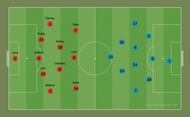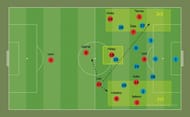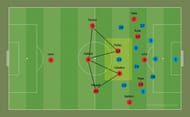In a game where Arsenal were the favourites, Leicester City crushed Mikel Arteta's men.
The Gunners succumbed to a 1-0 defeat at home at the hands of Leicester. What caused Arsenal to yield? We'll take a look at few of Mikel Arteta decisions that led Arsenal away from a victory and what he could've done better.
Arsenal's on-pitch formation & variability
Mikel Arteta deployed a midfield that was run by Granit Xhaka, Thomas Partey, and Dani Ceballos in what looked like a 4-3-3 formation, much to the fan's delight.
This trio was regarded as Arsenal's best midfielders and the game certainly left plenty disappointed.
However, on the pitch, the Gunners played a solid 3-4-3 without the ball with Xhaka dropping back as the left centre-back while playing a 2-3-5 with possession. Xhaka and Ceballos took the positions of auxiliary fullbacks.
Tierney is Arteta's preferred LCB but vs Leicester, Xhaka took on the role.
Bukayo Saka played as the left winger and Kieran Tierney took the left wing-back position -- a move to accommodate Xhaka, all things considered.

Leicester City came into the game with a plan to strike and they executed it well.
They blocked the midfield with a resurgent mid-block and forced Arsenal out wide every time they had possession. This played in Arsenal's favor during the first half, as Kieran Tierney's pinpoint crosses produced a plethora of problems for Leicester.
Timothy Castagne was unable to contain the marauding Scot, while Jonny Evans had a tough time defending against Lacazette and Aubameyang, who were consistently attacking the box.
Overloading the flanks
Thomas Partey played as the lone holding midfielder for Arsenal. As a result, it was quite easy for Leicester City to take him out of the game.
Harvey Barnes closely man-marked the Ghanaian, forcing Arsenal's centre-backs to pass wide, every time they received the ball, as Partey - the only passing option near the midfield - was blocked.

Arsenal, despite not having Partey control the proceedings, dominated Leicester City in every department.
The Gunners overloaded the flanks and attacked through the channels, with David Luiz. The veteran played 8 accurate long balls, bypassing Leicester's whole midfield many times with his world-class passing, this re-affirmed Arsenals' confidence in the game.
To a certain point, the 2-3-5 helped Arsenal contain Leicester's counter-attacks as well. Whenever the visitors saw a possession overturned, Arsenal had enough time to get bodies behind the ball as the ball usually broke deep in Leicester's own half, on the flanks.
This is backed by the fact that the Foxes only had 2 shots in the first half with zero attempts on target.
Arsenal was dominating the game as Leicester's wingbacks did not seem to have a remedy to counter it.
Lack of midfield penetration backfired for the Gunners
Early in the second half, David Luiz sustained a thigh injury which forced an unfortunate substitution for the Gunners.
Shkodran Mustafi entered the pitch. This was the turning point in the game, as Arsenal's sole creator had departed.
Ultimately, the pressure started to build on Arsenal. Neither Gabriel nor Mustafi possessed the ability David Luiz has. The Gunners' tempo slowly started to die with Leicester gradually gaining confident.
Gabriel passed to Xhaka.
Xhaka played it back to Gabriel.
Gabriel eventually found Mustafi and Mustafi passed it to Ceballos.
Ceballos played it back to the defence -- this is a summary of what happened in the second half.
Now, what did Mikel Arteta do wrong here? The 2-3-5 system, to start with, worked well for the Gunners as they showed intent and were active through the wide areas.
In time, it became predictable and Leicester pressed Xhaka/Ceballos whenever they had the ball, eventually ceasing any progressive passes.
Surprisingly, Arteta did nothing to alter it. Despite it becoming evident that Arsenal was struggling to create, the Spaniard continued with the same system.
For a good 30 minutes, Arsenal passed the ball sideways and backwards because they simply had no options to pass.
How Arteta could've brought Arsenal back into the game
From the 50th minute, Arsenal evidently lacked ideas. The system wasn't working, there was no movement in the final third, and fatigue seemed to have kicked in.
Arsenal forwards were inactive, and wingbacks were under pressure whenever they received the ball.
The best way to have countered this would have been to ask Dani Ceballos to play centrally alongside Partey, making it difficult for Barnes to commit to one player.
Eventually, this would've either dragged Maddison (#10) out of his position, leaving space for Bellerin and Pepe on the right or Mendy (#24) would've stepped out to cover Ceballos.
This would've given Lacazette enough space and time on the ball behind Leicester's midfield.

Although easier said than done, a double pivot gives the team a different dimension on the midfield, creating another passing lane and freeing Partey from the shackles of Barnes.
Ceballos and Partey would've eventually shown their authority on the game as they now have more space and time to receive the ball.
This may have a drawback. Brendan Rodgers' substitutions in the second half saw Cengiz Under and Jamie Vardy come in and that's added pressure for Arsenal's defence to cope with -- two pacy, counter-attacking threats.
How can Mikel Arteta improve in their next league game vs Man United?
Man United will adopt a similar strategy as Leicester City did; to hurt Arsenal on the break.
The Gunners prefer to play in a high defensive line and with the likes of Daniel James and Marcus Rashford, United will be excited at the prospect of making runs behind their defence.
The only difference would be Man United wouldn't play a 5-4-1 like Leicester, but Ole Gunnar Solskjær's preferred 4-2-3-1.
Mikel Arteta played Xhaka as the left centre-back vs Leicester and it backfired immensely. So that is not happening next week. However, we will definitely see the 3-4-3 that Arteta has favored all season; a formation which is known for its defensive structure.
The team which scores the first goal would likely prevail and the midfield battle would be what decides the game.
Scott McTominay and Fred are likely to retain their place which is why it would be absolutely crucial to play Partey and Ceballos in the double pivot.
Ole Gunnar Solskjær prefers to watch his team perform and the two resilient midfielders in Arsenal ranks, gives them the competitive advantage.
Midfield will be where the game will be decided and it was exactly where Arsenal lost the game vs Leicester.
Predicted Arsenal XI vs Man United: Leno, Tierney, Gabriel, Luiz; Saka, Ceballos, Partey, Bellerin; Aubameyang, Lacazette, Willian.
